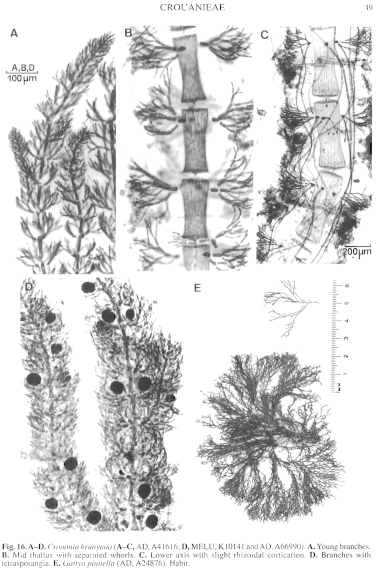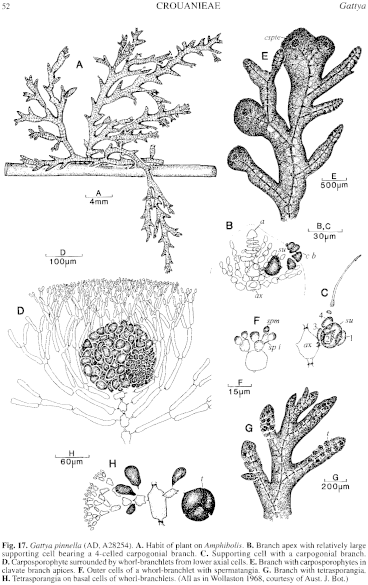|
|
|
|
|
|||||||||||
|
Electronic Flora of South Australia Species Fact Sheet
Phylum Rhodophyta – Order Ceramiales – Family Ceramiaceae – Tribe Crouanieae
Selected citations: J. Agardh 1876: 560; 1885: 9. Bastow 1899: pl. 2 fig. 151. De Toni 1903: 1422. Huisman 1997: 198. Huisman & Walker 1990: 423. Kützing 1866: 20, pl. 57f–h. Kylin 1956: 373, fig. 297A. Lucas 1909: 52. Lucas & Perrin 1947: 359, fig. 179. May 1965: 362. Mazza 1912: No. 418. Schmitz & Hauptfleisch 1897: 499, fig. 217E. Silva et al. 1996: 409. Sonder 1881: 26. Wollaston 1968: 247, figs 6–8.
Thallus (Figs 16E, 17A) medium red-brown, 2–10 cm high, firm, with alternately pinnate erect axes arising from prostrate lower parts, branches sympodially branched, compressed in the plane of branching with constrictions depending on new growth phases, branches with a gelatinous sheath. Attachment by rhizoids; epiphytic on Amphibolis or larger algae.
Structure. Apices with a row of 3–9 short cells 6–9 µm in diameter, axial cells enlarging below to 60–90 µm in diameter and L/D 2–4, basal axial cells lightly corticated with rhizoids; lateral branches arising from axial cells. Each axial cell with 3 (rarely 4) whorl-branches 250–450 µm long, closely adjacent, branched di- or trichotomously several times, basal cells 12–25 µm in diameter and L/D 1–2, adjacent cells L/D 5–6, tapering to subspherical terminal cells 5–8 µm in diameter. Cells uninucleate; rhodoplasts ovoid in smaller cells, elongate in larger cells.
Reproduction: Gametophytes dioecious. Procarps (Fig. 17B, C) produced in place of a whorl-branchlet near apices, with a large supporting cell bearing a 4-celled carpogonial branch. Post-fertilization the carpogonium connects with the auxiliary cell via a connecting cell and produces an erect rounded gonimolobe and later lateral gonimolobes, each 150–220 µm across with ovoid carposporangia 25–35 µm in diameter. Carposporophytes (Fig. 17D, E) occur in swollen branch ends. Spermatangia (Fig. 17F) are cut off from terminal cells of whorl-branchlets, ovoid, 2–3 µm in diameter.
Tetrasporangia (Fig. 17G, H) occur on basal cells of whorl-branchlets, produced successively, sessile, subsperical, 45–60 µm in diameter, tetrahedrally divided.
Type from Rottnest I., W. Aust. (Harvey); lectotype in Herb. Harvey, TCD (Tray. Set 223).
Selected specimens: Middleton Beach, Albany, W. Aust., drift (Norris 2258, 23.iii.1959; AD, A39323). Ward I., S. Aust., on Metagoniolithon radiatum 18–23 m deep (Shepherd, 3.iii.1980; AD, A50914). Hardwicke Bay, York Pen., S. Aust., on Posidonia australis, drift (Gordon-Mills, 26.v.1981; AD, A52191). N Spencer Gulf, S. Aust., 18 m deep (Shepherd, 13.ix.1973; AD, A44306). Stenhouse Bay, S. Aust., on Areschougia congesta, 3–4 m deep (Cannon, 15.x.1988; AD, A59174). Investigator Strait, S. Aust., epiphytic, 31 m deep (Watson, 23.i.1971; AD, A41124). Marino, S. Aust., on Chiracanthia, drift (Womersley, 4.x.1964; AD, A28228). Seacliff, S. Aust., on bryozoan, drift (Wollaston, 7.x.1964; AD, A28254). Victor Harbor, S. Aust., drift (Womersley, 17.x.1948; AD, A9237). Nora Creina, S. Aust., drift (Womersley, 8.viii.1961; AD, A24826) and on Apjohnia, 5–6 m deep (R. Lewis & Kraft, 13.v.1972; AD, A42218). Port MacDonnel], S. Aust., on Rhodymenia, drift (Womersley, 24.xi.1992; AD, A62219). Crawfish Rock, Westernport Bay, Vic., on Areschougia congesta, 2 m deep (Watson & Womersley, 16.i.1974; AD, A44892). Port Phillip Heads, Vic., epiphytic (Wilson, 29.xii.1892; MEL, 8441). San Remo, Vic., on Areschougia congesta, drift (Sinkora A531, 14.vi.1970; AD, A62648). Franklin Sound, Flinders I., Bass Strait, epiphytic, 5 m deep (Watson, 13.xii.1972; AD, A43008). Currie R., Tas. (Perrin, 1.xi.1948; BM).
Distribution: Houtman Abrolhos, W. Aust. (Huisman 1997), to Westernport Bay, Vic., and N Tasmania.
References:
AGARDH, J.G. (1876). Species Genera et Ordines Algarum. Vol. 3, Part 1- Epicrisis systematic Floridearum, pp. i-vii, 1–724. (Weigel: Leipzig.)
AGARDH, J.G. (1885). Till algernes systematik. VII. Florideae. Acta Univ. lund. 21, 1–120, Plate 1.
BASTOW, R.A. (1899). Key to tribes and genera of the Florideae. J. Proc. R. Soc. N.S.W. 33, 45–47, Plates 1, 2.
DE TONI, G.B. (1903). Sylloge Algarum omnium hucusque Cognitarum. Vol. 4. Florideae. Sect. 3, pp. 775–1521 + 1523–1525. (Padua.)
HARVEY, W.H. (1855a). Some account of the marine botany of the colony of Western Australia. Trans. R. Jr. Acad. 22, 525–566.
HARVEY, W.H. (1859a). Phycologia Australica. Vol. 2, Plates 61–120. (Reeve: London.)
HARVEY, W.H. (1863). Phycologia Australica. Vol. 5, Plates 241–300, synop., pp. i-lxxiii. (Reeve: London.)
HUISMAN, J.M. & WALKER, D.I. (1990). A catalogue of the marine plants of Rottnest Island, Western Australia, with notes on their distribution and biogeography. Kingia 1, 349–459.
HUISMAN, J.M. (1997). Marine Benthic Algae of the Houtman Abrolhos Islands, Western Australia. In Wells, F.E. (Ed.) The Marine Flora and Fauna of the Houtman Abrolhos Islands, Western Australia, pp. 177–237. (W. Aust. Museum: Perth.)
KÜTZING, F.T. (1866). Tabulae Phycologicae. Vol. 16. (Nordhausen.)
KYLIN, H. (1956). Die Gattungen der Rhodophyceen. (Gleerups: Lund.)
LUCAS, A.H.S. & PERRIN, F. (1947). The Seaweeds of South Australia. Part 2. The Red Seaweeds. (Govt Printer: Adelaide.)
LUCAS, A.H.S. (1909). Revised list of the Fucoideae and Florideae of Australia. Proc. Linn. Soc. N.S.W. 34, 9–60.
MAY, V. (1965). A census and key to the species of Rhodophyceae (red algae) recorded from Australia. Contr. N.S.W. natn. Herb. 3, 349–429.
MAZZA, A. (1912). Saggio di Algologia Oceanica. Nuova Notarisia 23, Nos. 415–447.
SCHMITZ, F. & HAUPTFLEISCH, P. (1897). Ceramiaceae. In Engler, A. & Prantl, K., Die natarlichen Pflanzenfamilien, Vol. 1, Part 2, pp. 481–504. (Leipzig.)
SILVA, P.C., BASSON, P.W. & MOE, R.L. (1996). Catalogue of the Benthic Marine Algae of the Indian Ocean. (University of California Press: Berkeley, Los Angeles & London.)
SONDER, O.W. (1881). In Mueller, F., Fragmenta Phytographiae Australiae. Supplementum ad volumen undecinum: Algae Australianae hactenus cognitae, pp. 1–42, 105–107. (Melbourne.)
WOLLASTON, E.M. (1968).Morphology and taxonomy of southern Australian genera of Crouanieae Schmitz (Ceramiaceae, Rhodophyta). Aust. J. Bot. 16, 217–417.
The Marine Benthic Flora of Southern Australia Part IIIC complete list of references.
Publication:
Womersley, H.B.S. (24 December, 1998)
The Marine Benthic Flora of Southern Australia
Rhodophyta. Part IIIC. Ceramiales – Ceramiaceae, Dasyaceae
©State Herbarium of South Australia, Government of South Australia
Illustrations in Womersley Part IIIA, 1998: FIGS 16E, 17.

Figure 16 enlarge
Fig. 16. A–D. Crouania brunyana (A–C, AD, A41616; D, MELU, K10141 and AD, A66990). A. Young branches. B. Mid thallus with separated whorls. C. Lower axis with slight rhizoidal cortication. D. Branches with tetrasporangia. E. Gattya pinnella (AD, A24876). Habit.

Figure 17 enlarge
Fig. 17. Gattya pinnella (AD, A28254). A. Habit of plant on Amphibolis .B. Branch apex with relatively large supporting cell bearing a 4-celled carpogonial branch. C. Supporting cell with a carpogonial branch. D. Carposporophyte surrounded by whorl-branchlets from lower axial cells. E. Branch with carposporophytes in clavate branch apices. F. Outer cells of a whorl-branchlet with spermatangia. G. Branch with tetrasporangia. H. Tetrasporangia on basal cells of whorl-branchlets. (All as in Wollaston 1968, courtesy of Aust. J. Bot.)

|
Email Contact: State Herbarium of South Australia |

|